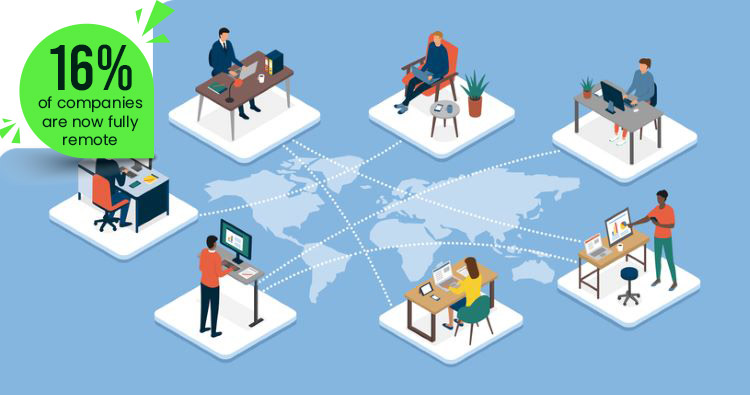…if you haven’t already, that is.
Seriously, who hasn’t either wholly or partially embraced remote work or working from home (WFH) these days? Or at least is seriously considering it?
If there’s any silver lining to the pandemic, it’s that we’ve seen that for a lot of industries, there’s a better way of doing things. And while remote work isn’t perfect (is anything?), the benefits still outweigh the challenges by a mile for businesses and employees alike.
But okay, we’re all about the benefits of remote working for more than a decade now, so perhaps we’re a bit biased. You can’t, however, argue with numbers.
So, today, let’s take a look at the latest ones pertaining to remote work:
1.) Globally, 16% of companies are now fully remote.

This is according to the latest Owl Labs study on remote work. It might not be a huge number, but bear in mind that fully remote companies operate with no brick and mortar offices or headquarters. At all.
Hence, it’s highly possible to operate remotely 100%, and I suspect this number will only go up in the coming years.
2.) The number of people who work from home has risen by 159% since 2009.

That’s a massive change in just 13 years. Lots of factors have contributed to this. Chief among them are rapid technological advancements, the rise of jobs that can be done remotely, and the increasing number of key talents seeking a better work-life balance in their careers.
3.) Over 50% of remote workers have started working from home since 2020.

A big chunk of that 159% only got started with remote work less than two years ago, at least according to Gitlab. This just reveals how quickly remote work has become mainstream (though perhaps the pandemic did speed things up considerably).
4.) ⅔ of businesses are investing in web-conferencing software.

If you need further proof of how remote work is the future, look at the demand for the tools that make it possible.
As of April 2021, Trust Radius discovered that 67% of businesses invested heavily in web-conferencing software. This was the largest increase in B2B software spending, followed by expenses for collaboration tools (57%) and remote desktop tools (52%).
5.) The industries with the highest number of remote workers are healthcare (15%), technology (10%), and financial services (9%).

It’s easy to associate remote work with the tech industry or with digital marketing, and with good reason.
Surprisingly, though, healthcare is the industry with the most remote workers. This just means that there will always be remote opportunities in just about every and any industry.
6.) By 2028, 73% of all departments are projected to have remote workers.

And speaking of more remote opportunities, it looks like remote work will be more acceptable – perhaps even expected – throughout most companies. We can also deduce that more and more roles will evolve to be remote-friendly.
7.) 77% of remote workers believe they are more productive working from home.

Do you still believe that the absence of direct supervision leads to low productivity? If so, it looks like the majority of workers would disagree with you.
Quite the contrary, they find it easier to work without the distractions that office politics and micromanaging can bring.
8.) 69% of millennials would give up certain work benefits for a more flexible working space.

Just how much does the younger generation value a good work-life balance? So much so that they’re willing to forego certain benefits.
Remote work is the new signing bonus indeed.
9.) Remote work reduces greenhouse gas emissions by the equivalent of about 600,000 cars.

This is quite simple, really. With less people commuting and driving, there will be less vehicles on the roads.
So, if you ever wanted to leave a better world for the next generation, remote working is the way to go.
10.) Companies that allow remote work see an average increase of US$2,000 in profit per remote worker.

Remote work doesn’t just benefit employees. Companies also get to save significant sums as well. Think savings on office space, utilities, supplies, and travel reimbursements. It all adds up.
11.) 64% of recruiters claim that a work-from-home policy helps them find high-quality talent better.

In other words, more than half of recruiters find it easier to find top talent when a position is either partially or fully remote.
Adapting a remote work policy could give you a leg-up on the talent war.
There we have it. The latest numbers only confirm what we’ve been saying all along: that remote work is largely the way to go if you want your company to go further.
Remote Staff has been assisting AU SME’s and entrepreneurs find talented remote workers from the Philippines long before outsourcing and remote working became mainstream. Whether it’s your first time to try a remote workforce or are looking for top talent to beef up your existing one, we’ve got you covered.
Call us today or schedule a call back so we can get started.
Serena has been working remotely and writing content for the better part of the last decade. To date, she's written for Pepper.ph and Mabuhay Magazine, among others, and has churned out more than a thousand articles on everything from The Basics of Stock Market Investing to How to Make Milk Tea-Flavored Taho at home. Hermits, aspiring hermits, and non-hermits with interesting project propositions may email her at serena.estrella10@gmail.com.





















